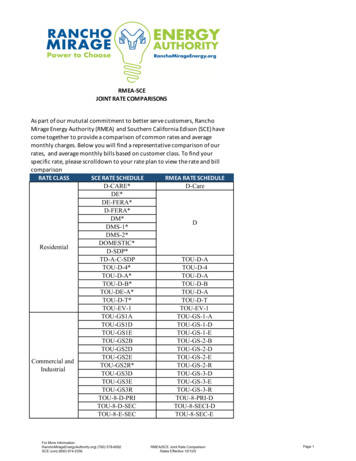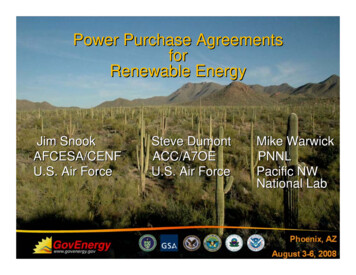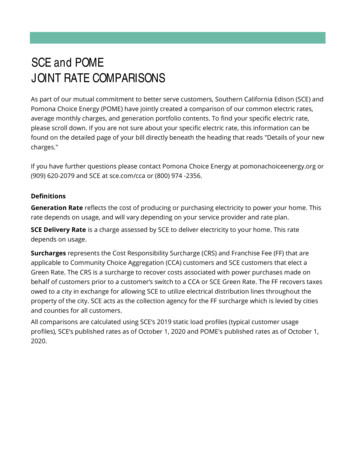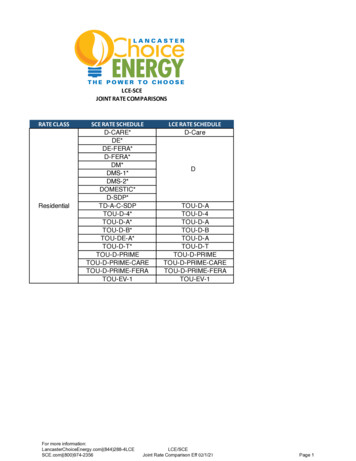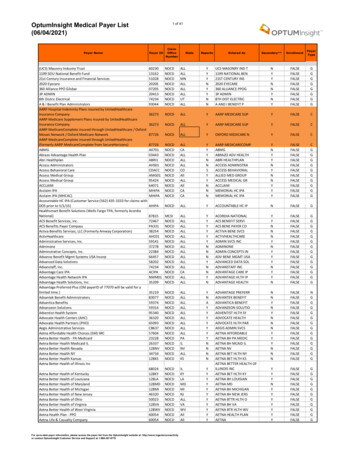
Transcription
1Reassessing the Allegiance to Renewable Energy, Considering the Needsto Adopt Zero Emission Energy and Restore Our SoilCoty Keller with insights from John E Darovec and Jack & Carmen MerriamJune 13, 2022Note for readers: underscored links in the text provide references to sourcesWe are running out of time to act effectively on the climate crisis. Every minute, every ounce ofpersonal and physical energy, every dollar is crucial in the race to keep global warming below1.5OC increase over preindustrial levels. With that in mind, let’s take a look at the adequacy ofvarious so called “renewable energy.” We will find that while some forms of renewable energyare beneficial, other renewables are not acceptable.Defining the problem and the solutionThe climate crisis is the result of human activity upsetting the balance of the natural carboncycle. Heat-trapping gases in the atmosphere have two causes: Human caused heat-trappinggas emission (the UP arrow in the illustration), and deforestation and poor soil managementwhich eliminate nature’s ability to remove heat-trapping gases (the DOWN arrow).Illustration credit : Urgency & Action: Drawdown to reverse global warming. FloridaVeterans for Common Sense.The general solution, depicted in the illustration, is to get greenhouse gases down below 350ppm, which comes from two specific solutions (1) reduce and then eliminate human causedemissions, which has to happen quickly- 70-100% by 2030 and (2) remove heat trapping gasesReassessing the Allegiance to Renewable Energy, Considering the Needs to Adopt ZeroEmission Energy and Restore Our Soil
2from the atmosphere by restoring photosynthesis through reforestation and good soilmanagement.Defining and distinguishing between renewables and zero emission energy sourcesAccording to the NRDC, EIA, and DOE, renewable energy is energy that comes from naturalsources or processes that are constantly replenished. The table lists the major types ofrenewable energy. On the left we have the renewables that have become part of the climateproblem because they emit heat trapping gasses (plus some are harmful to our soil); on theright we have non emitting renewables.Major Types of Renewable EnergyBiomass sources of energy - create heat trappinggases. Wood and wood wasteMunicipal solid wasteLandfill gas and biogasEthanolBiodieselNon emitting sources of energy HydropowerGeothermalWindSolarSources NRDC, EIA, DOEBiomass is organic material that comes from plants and animals, and includes crops, wastewood, and trees. The US Energy Information Administration (EIA) points out that Biomass isoften mistakenly described as a greener alternative to coal and other fossil fuels. However,recent science shows that many forms of biomass—especially from forests—produce highercarbon emissions. The old idea behind biofuels, another type of biomass, is that they can - intheory- offer a carbon neutral fuel source because the emissions caused by burning them hasalready been offset by the carbon dioxide taken up in their creation.The Union of Concerned Scientists notes, however, that the farming and machinery used togrow, harvest and take biofuel crops to market emit more heat trapping gases than the biofuelcrops take from the air. Ethanol and biodiesel are destructive to the soil because the way cornand soybeans are farmed relies on heavy doses of pesticides, synthetic fertilizer and amonoculture farming practice that depletes microbes needed for healthy soil. This leaves thesoil susceptible to erosion, unsuitable for farming healthy produce and takes aways its ability tocapture and store heat trapping gasses. Biofuels are wreaking havoc on both sides of theup/down illustration.It is important to recognize that all forms of biomass emit heat-trapping gases when burned,Reassessing the Allegiance to Renewable Energy, Considering the Needs to Adopt ZeroEmission Energy and Restore Our Soil
3and thus contribute to the climate crisis. Others, particularly biofuels also degrade soil health,further contributing to the problem. We need to stop using them.Zero emissions, not renewability is the important property for our energy sourcesTo reduce, and expeditiously eliminate human caused emissions, the technical solution is prettymuch agreed on by the experts (Project Drawdown, Union of Concerned Scientists -Solutions.Bill Gates- How to Avoid a Climate Disaster). We must reduce energy consumption. We need toelectrify almost everything and generate all our electricity from zero emission sources ofenergy. It is therefore of utmost importance that everyone understands what those sourcesare.Project Drawdown is the result of meticulous research by leading scientists and policymakersfrom around the world. They detail the 100 most substantive solutions to the climate crisis.Seven zero emission energy sources are included in the solutions. They are listed in the tablebelow.Zero Emission Energy Sources Wind turbines (Onshore is #2 of 100; Offshore is #22) Solar farms (#8) Rooftop Solar (#10) Geothermal (#18) Nuclear (#20) Solar hot water (#41) Small hydropower (#48)PS: The highest ranked solutions are not energy source related.They are Refrigeration Management (#1) and Educating Girls (#6) & Family Planning (#7) – the two of which combined top thewhole list.Source: Hawken, Paul editor. 2017. Drawdown: the mostcomprehensive plan ever proposed to reverse global warming.Penguin Books. https://www.drawdown.org/The wind, solar and geothermal sources need no explanation. Small hydropower systems areworthy of note because they capture the energy of free-flowing water, without using a dam.They can replace dirty diesel generators with clean electricity generation. Old style hydropowerconjures images of massive, landscape-shattering dams, such as the Three Gorges on uppertributaries of the Yangtze River in China. Large hydroelectric dams produce enormous amountsof electricity, but they also swallow up vast swaths of natural and human habitat. They impactwater movement and quality, sediment patterns, and fish migration. Smaller in-stream turbinesare different. Placed within a free-flowing river or stream, they capture water’s kinetic energywithout creating a reservoir and its repercussions. The underwater analogue to wind turbines,Reassessing the Allegiance to Renewable Energy, Considering the Needs to Adopt ZeroEmission Energy and Restore Our Soil
4their blades rotate as water moves past, generating relatively continuous electricity. Nobarriers, diversions, or storage are required, only limited structural support. And best of all, noheat trapping gases are emitted.The Union of Concerned Scientists and Project Drawdown recognize what they call the “nucleardilemma.” Nuclear power is slow, expensive, risky, and creates radioactive waste, but it has thepotential to avoid emissions from fossil fuel electricity. Stopping emissions is the goal, sonuclear power must be allowed to compete with other zero emission sources. As far as risksgo, this fact may put things in perspective: nuclear power has never killed an American. Fossilfuel pollution is killing Americans every day and that number is increasing exponentially, withclimate related disasters On a personal note, I must (as a Navy veteran) add that nuclear powerhas driven US Navy vessels including ships the size of cities, for 75 years. without seriousincident. Nuclear power is an important contributor of zero emission energy.What about Hydrogen? Hydrogen itself is not an energy source, but hydrogen fuel cells are anenergy source that produce no heat trapping gas emissions. They will be valuable (if notessential) to power aircraft, long haul trucks and other modes of transportation that will not besolved by electric motors due to battery/range constraints. What matters is the source ofenergy used to create the hydrogen and store it in the fuel cell. Hydrogen fuel cells arebeneficial if the hydrogen is created and stored by using zero emission energy sources (wind,solar, geothermal, nuclear, small hydro).What to do with this information?We can all be part of the solution. Here are some ideas for action.We need to stop emitting heat-trapping gases and improve soil management. Given theurgency of the situation (IPCC 2018: severe economic and humanitarian crises by 2030 if wedon’t take bold action), a radical shift in thinking and action is required. This requiresabandoning certain renewable sources of energy. We should commit to not uttering the term“renewable,” and when others use the term, take their remarks with a grain of salt.Consider giving up the use of your fireplace. Burning firewood (or any biomass) emits heattrapping gas and contributes to the problem. You can seal off your fireplace to help preserveyour home’s heating/cooling envelope. If you use the fireplace to heat your home, consider theshift to electric heat pump and ideally power your home from solar energy (community solar oryour own rooftop solar).Stop supporting campaigns for “100% clean and renewable energy.” While some of theseprograms have produced marginal improvements, they are not efficient or effective enough toget us to 70-100% reduction/elimination of emissions by 2030. Instead, encourage the use ofresources -including political capital -on programs that implement concrete, effective andefficient policies such as low carbon portfolio standards. LCPSs are a more effective andaffordable way to reduce carbon emissions because they require utilities to purchase lowcarbon electricity produced form zero emission sources.Reassessing the Allegiance to Renewable Energy, Considering the Needs to Adopt ZeroEmission Energy and Restore Our Soil
5Support Carbon Fee and Dividend. A national price (a fee) on emission, is the fastest and mostequitable way to reduce our nations emissions. It’s equitable because the dividends arereturned monthly to households and help low and middle income families pay the elevated costof a fossil fuel economy.Let’s re-purpose and re-name government agencies (for example the National RenewableEnergy Lab, and DOE’s office of energy efficiency and renewable energy) to focus on mitigatingthe climate crisis instead of the proliferation of exclusively renewable energy programs.The plant-rich diet is #4 of Drawdown’s 100 solutions. As Zen master Thich Nhat Hanh has said,making the transition to a plant-based diet may be the most effective way an individual canstop climate change.We also can stop subsidizing farmers to grow corn and soybeans to make biofuels. Let’s stoppaying people to produce harmful energy and deplete our soils using pesticide requiringmonocrops. Instead, we should be paying farmers to store carbon, help the climate and savefarms.We should understand the solutions that farmers could employ because they not only attackthe climate crisis, but they also improve our food system. A few of them are sown in the table.Some Food System SolutionsSilvopasture (9 of 100)Regenerative Agriculture (#11)Source: Hawken, Paul editor. 2017. Drawdown: the most comprehensiveplan ever proposed to reverse global warming. Penguin Books.https://www.drawdown.org/Silvopasture is an ancient practice that integrates trees, pasture, and forage into a singlesystem. Incorporating trees improves land health and significantly increases carbonsequestration. Carbon aside, the advantages of Silvopasture are considerable, with financialbenefits for farmers and ranchers. Livestock, trees, and any additional forestry products, suchas nuts, fruit, and mushrooms, generate income on different time horizons. The health andproductivity of both animals and the land improve. Because silvopasture systems are diverselyproductive and more resilient, farmers are better insulated from risk.Conventional wisdom has long held that the world cannot be fed without chemicals andsynthetic fertilizers. Evidence points to a new wisdom: The world cannot be fed unless the soilis fed. Regenerative agriculture enhances and sustains the health of the soil by restoring itscarbon content, which in turn improves productivity—just the opposite of conventionalagriculture. Regenerative agricultural practices include: no tillage, diverse cover crops, in-farm fertility (no external nutrients),Reassessing the Allegiance to Renewable Energy, Considering the Needs to Adopt ZeroEmission Energy and Restore Our Soil
6 no pesticides or synthetic fertilizers, and multiple crop rotations.Together, these practices increase carbon-rich soil organic matter. The result: vital microbesproliferate, roots go deeper, nutrient uptake improves, water retention increases, plants aremore pest resistant, and soil fertility compounds.It makes sense to incentivize silvopasture and regenerative agriculture instead of the madnessof paying farmers to grow corn and soybeans for biofuels.We can act in or own yards and neighborhoods. Using electric or battery operated landscapeequipment, powered by the sun, eliminates the pollution from gas and diesel fuels.Using composting (#60 on the Drawdown list) instead of synthetic fertilizer results in less heattrapping gas emissions and soil better able to store carbon. Native trees, shrubs and grasses areable to tolerate natural soils and local rainfall patterns, salt air, etc. Natives also fight off theloss of diversity by their long-established relationships with the local insects, birds and otherwildlife. Through photosynthesis, they sequester carbon. Replacing lawns that use fertilizerscan reduce heat trapping gas emissions. Nitrous oxide emissions (including those from fertilizer)are 300 times more potent than carbon dioxide.Projects that replace parking lots, and other spaces with native trees and shrubs can workwonders for our communities. Afforestation, creating new forests where there were nonebefore, is Project Drawdown’s #15 of 100 solutions for the climate crisis.ConclusionSome forms of renewable energy can help solve the climate crisis, but others contribute to theproblem by creating emissions and degrading our soils. Focusing on renewable distracts usfrom the urgent task at hand of STOPPING all emissions, restoring full photosynthesis, andimproving the management of our soil. Let’s drop the renewable concepts and instead focuson zero emission sources of energy (wind, solar, geothermal, nuclear, and small hydro) andbeneficial farming/land management practices (regenerative agriculture, silvopasture,afforestation, composting. We don’t have time or energy to waste. There is plenty for us all todo NOW.Click here to Return to HomepageReassessing the Allegiance to Renewable Energy, Considering the Needs to Adopt ZeroEmission Energy and Restore Our Soil
The plant-rich diet is #4 of Drawdown's 100 solutions. As Zen master Thich Nhat Hanh has said, making the transition to a plant-based diet may be the most effective way an individual can stop climate change. We also can stop subsidizing farmers to grow corn and soybeans to make biofuels. Let's stop


